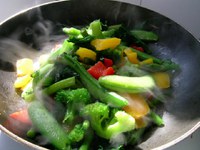Prairie Fare: Frozen Foods Have Inspired Menus for More Than 80 Years
(Click the image below to view a high-resolution image that can be downloaded)
By Julie Garden-Robinson, Food and Nutrition Specialist
NDSU Extension Service
As I pondered a potential column topic, someone tossed an idea my way. How about writing something about frozen foods?
I must admit, after our intensely cold winter, I am dreaming of hot, grilled foods cooked and eaten outdoors on a warm day. Thinking about frozen food made me shiver.
The other day, I went to a warehouse-type grocery store. Wearing my warmest winter coat, I did the “penguin walk” as I slowly worked my way across the icy parking lot. As I pushed my cart around the huge store, the appeal of the frozen foods topic grew when I reached the aisles of super-sized freezers.
Many types of frozen foods were beckoning me. I paused before I added too much to my cart. I do not have a huge freezer in my home to fit all the appetite-inspiring foods. Our parents, grandparents and/or great-grandparents did not have all these food options.
Prior to the 1930s, modern freezing equipment was not available. Then Clarence Birdseye introduced his game-changing freezing process and equipment. He used a conveyor-belt process to freeze many types of meat, fish fillets, berries, spinach and peas.
Frozen foods have come a long way since their initial introduction to consumers more than 80 years ago. Some of the early frozen foods were described as “cardboardlike” in terms of flavor and texture. Grocers were hesitant about buying the large equipment needed to display and sell the frozen goods.
Frozen foods could have been abandoned had it not been for World War II, according to the National Frozen and Refrigerated Foods Association.
During World War II, the U.S. experienced a shortage of tin because the metal was needed for the war effort. Because the canned food industry was short on packaging and processing supplies, the frozen foods industry took great strides. Frozen canned orange juice became a top-selling item in the 1940s.
The 1950s brought the TV dinner to the forefront of frozen food popularity. The early TV dinners weren’t exactly gourmet meals, but these novel foods eased food preparation among busy families.
The Agriculture Research Service (ARS) of the U.S. Department of Agriculture has conducted research to improve the quality of frozen foods. For example, research scientists substituted rice flour for wheat flour as a thickener in gravies used in early frozen dinners. The frozen gravy made with rice flour did not separate or become lumpy. The ARS also has developed techniques to maintain the flavor of frozen orange juice.
We can learn from the processes developed by the ARS when we freeze our own foods. These principles apply whether we are in a commercial food plant or freezing foods in our own kitchen. If you buy extra fresh food, consider freezing the excess.
- Choose appropriate foods to freeze. For example, cucumbers and lettuce do not freeze well, but peas do.
- Only freeze the best-quality foods. Freezing does not improve the quality of foods.
- Freeze foods promptly. If you buy extra fruits or vegetables at the grocery store, freeze them as soon as you can. For example, if you will not use fresh meat within a couple of days, freeze it in recipe-sized amounts.
- Be sure to blanch (heat-treat) most fresh vegetables prior to freezing. The “Food Freezing Guide” at http://www.ag.ndsu.edu/pubs/yf/foods/fn403.pdf provides advice about freezing a wide range of foods.
- Use the proper packaging. Improper packaging can result in flavor, color and texture changes associated with freezer burn. Although “freezer burn” is not a food safety issue, it is a quality issue. You may end up throwing away freezer-burned foods. Pages 21 to 22 of the online Food Freezing Guide provide directions about various wrapping techniques, including the drugstore wrap, butcher wrap, casserole wrap and bundle wrap.
- Set your freezer at zero Fahrenheit or lower so your frozen food remains solidly frozen.
Here’s a colorful recipe featuring frozen vegetables. It’s from the University of Florida Extension, where the weather is mild all year. Stay warm with this tasty and nutritious dish.
Sweet and Sour Stir-fried Vegetables
1 Tbsp. honey
1 Tbsp. lemon juice
1 tsp. soy sauce, low-sodium
1/4 tsp. ginger
1 c. orange juice
1 Tbsp. cornstarch (for thickening)
2 tsp. canola oil
1 pound frozen stir-fry vegetables (carrots, broccoli, snap peas, peppers, squash, etc.)
Combine all the ingredients, except oil and vegetables, in a bowl. Heat the oil on medium in a large skillet, then add vegetables. Cook the vegetables for about four minutes, until the vegetables are crisp-tender and heated through. Add the sauce ingredients, then cook for about two minutes, until the mixture comes to a boil and thickens slightly. Serve immediately over brown rice or noodles.
Makes six (1/2-cup) servings. Each serving has 80 calories, 1.5 grams (g) of fat, 1 g of protein, 14 g of carbohydrate, 1 g of fiber and 45 milligrams of sodium.
(Julie Garden-Robinson, Ph.D., R.D., L.R.D., is a North Dakota State University Extension Service food and nutrition specialist and professor in the Department of Health, Nutrition and Exercise Sciences.)
NDSU Agriculture Communication – Feb. 13, 2014
| Source: | Julie Garden-Robinson, (701) 231-7187, julie.garden-robinson@ndsu.edu |
|---|---|
| Editor: | Rich Mattern, (701) 231-6136, richard.mattern@ndsu.edu |


